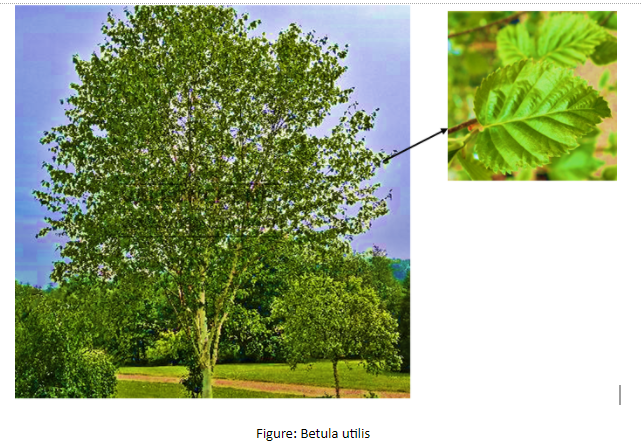
‘Bhojpatra’ is derived from the leaves of:
(a)Cinchona
(b)Dalbergia sissoo
(c)Betula utilis
(d)All of the above
Answer
578.7k+ views
Hint: This tree is widely found in the Himalayan region which is growing at elevations up to 4,500 m (14,800 ft). It is well known for the use of the different parts of the tree in ancient India.
Complete step-by-step answer:
‘Bhojpatra’ is derived from the leaves of Betula utilis. In ancient times the paper-like bark of Betula utilis was used for writing Sanskrit scriptures, texts, and ancient mantras (with the bark placed in an amulet and worn for protection). Some areas of its native habitat are being lost due to overuse of the tree for firewood but selected varieties are used for landscaping.
Additional Information:
- Cinchona is a genus of flowering plants and has at least 24 species of trees and shrubs. All are native to western South America and trees grow up to 15 meters (50 feet) and in humid forests between 1,300-2,900 meters above sea level.
People use the bark of the tree to make medicine. Cinchona is used for releasing digestive juices, treating bloating, fullness, and other stomach problems. It is also used for blood vessel disorders including varicose veins, and leg cramps.
- Dalbergia sissoo is a fast-growing native to the Indian Subcontinent and Southern Iran and known as North Indian rosewood. The tree is large, with long, leathery leaves and whitish or pink flowers.
Dalbergia sissoo is used as folk medicine and remedies such as gonorrhea and skin ailments. Ayurvedics prescribe the leafy juice for eye ailments, and the wood is used in India for boils, leprosy, and nausea.
So, the correct answer is ‘Betula utilis’.

Note: The bark of Betula utilis is also used as a medicine, for skin diseases and ear diseases. The herb has properties of healing wounds. It is also used in treating kidney and bladder disorders. Also, it is effective for the treatment of obesity.
Complete step-by-step answer:
‘Bhojpatra’ is derived from the leaves of Betula utilis. In ancient times the paper-like bark of Betula utilis was used for writing Sanskrit scriptures, texts, and ancient mantras (with the bark placed in an amulet and worn for protection). Some areas of its native habitat are being lost due to overuse of the tree for firewood but selected varieties are used for landscaping.
Additional Information:
- Cinchona is a genus of flowering plants and has at least 24 species of trees and shrubs. All are native to western South America and trees grow up to 15 meters (50 feet) and in humid forests between 1,300-2,900 meters above sea level.
People use the bark of the tree to make medicine. Cinchona is used for releasing digestive juices, treating bloating, fullness, and other stomach problems. It is also used for blood vessel disorders including varicose veins, and leg cramps.
- Dalbergia sissoo is a fast-growing native to the Indian Subcontinent and Southern Iran and known as North Indian rosewood. The tree is large, with long, leathery leaves and whitish or pink flowers.
Dalbergia sissoo is used as folk medicine and remedies such as gonorrhea and skin ailments. Ayurvedics prescribe the leafy juice for eye ailments, and the wood is used in India for boils, leprosy, and nausea.
So, the correct answer is ‘Betula utilis’.

Note: The bark of Betula utilis is also used as a medicine, for skin diseases and ear diseases. The herb has properties of healing wounds. It is also used in treating kidney and bladder disorders. Also, it is effective for the treatment of obesity.
Recently Updated Pages
Master Class 12 Business Studies: Engaging Questions & Answers for Success

Master Class 12 Economics: Engaging Questions & Answers for Success

Master Class 12 English: Engaging Questions & Answers for Success

Master Class 12 Maths: Engaging Questions & Answers for Success

Master Class 12 Social Science: Engaging Questions & Answers for Success

Master Class 12 Chemistry: Engaging Questions & Answers for Success

Trending doubts
What is meant by exothermic and endothermic reactions class 11 chemistry CBSE

Which animal has three hearts class 11 biology CBSE

10 examples of friction in our daily life

One Metric ton is equal to kg A 10000 B 1000 C 100 class 11 physics CBSE

1 Quintal is equal to a 110 kg b 10 kg c 100kg d 1000 class 11 physics CBSE

Difference Between Prokaryotic Cells and Eukaryotic Cells




